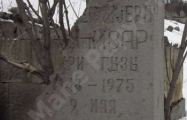The investigation by the Armenian journalist Mane Papyan about the bloody events against Azerbaijanis in Armenia in the late 80s of the last century has caused a resonance in Armenia. Of course, hearing the reality from Armenian journalist and her courage was unexpected for Azerbaijani media and social networks too.
As we mentioned before, pogroms against Azerbaijanis had happened long before Sumgait events: Armenians shed blood of Azerbaijanis in Kafan in 1978; The most tragic events took place in Gukark region of Armenia (now Lori region), where Armenians killed 70 Azerbaijanis and burnt alive another 13 in Vartan village.
Why does the Armenian journalist find it necessary to make public the facts exposing her compatriots? What made her to take this step? Has she been threaten for her step?
Mane Papian answered all these questions:
"Thank you for appreciating my work. I always stand for truth, no matter how bitter it may be. I learned about Gukark events a few months ago, and as a journalist, I think that if something happens, a journalist should write about it. Of course, it was hard to me as a citizen of Armenia to write about Gukark .
Mane Papyan’s article about the mass killings of Azerbaijanis in Gukark 27 years ago was published in Armenian website Epress.am. She writes:
`What happened to Azerbaijanis in Gugark (the region of Lori in the north of Armenia) before the Sumgait events is something that nobody in Armenia wants to remember or talk about. Any information related to the Gugark events is available only in the Azerbaijani sources.`
An atmosphere of fear reigned on both sides. The Armenians as well as the local Azerbaijanis in Gugark were afraid of an attack from the other side.
Arthur Sakunts, an activist and former member of the Karabakh Committee, notes that the Committee members were most of all concerned about a possible provocation. And for the purpose of decreasing the possibility of provocations, they were guarding the city at nights, but still could not ensure its full protection. “While the Azerbaijanis from the Azerbaijani village in Armenia called Arjut were transported by trucks at night, there were cases of Armenians attacking the convoys of cars,” Arthur Sakunts says, Mane Papyan writes.
All the roads out from the Azerbaijani villages were closed and protected by the army and police.
The former prosecutor of Vanadzor (the center of Lori region) Grigori Shahverdyan created and preserved his own archive with the documents that can shed light on many events from these dark days. He kept the addresses of the Azerbaijani families of the town for the purpose of ensuring their protection and had asked them to call him in case anything happened.
According to the archive, throughout March – November 1988, 628 Azerbaijanis were fired from different organizations and factories in the Gugark region. Those who worked in the strategically important fields, such as the water industry, were discharged first.
In those several months, 42 cases of ethnic confrontations in Vanadzor were registered (according to the archive document dated 10 November 1989). Since March 1988, there were attacks on Azerbaijani houses, as well as beating and robbery cases including at the work places. Azerbaijanis were easy to find on the local market since they comprised a large group of marketplace traders. There were cases when Armenians beat the Azerbaijani marketplace traders, and stole their produce such as fur or chicken. All those cases were registered by the prosecutor and his staff. The cases were thoroughly examined and followed by arrests of many people accused of violence.
The most frequent cases were the ones of Armenian young people attacking Azerbaijani houses and forcing them to leave. As a result, 37 Azerbaijani families left their houses.
In 1988, the Head of the Investigation Group of the USSR Prosecutor’s Office V.A. Reva compiled a document with a comparison of the crimes based on an ethnicity bias.
In November, the epicenter of Gugark events was the village of Shamunyan, which was populated mostly by Azerbaijanis. According to official sources, 11 Azerbaijanis were killed there. The reaction was immediate from the official institutions both in Armenia and in Moscow. A group of around 100 experts arrived from Moscow to Gugark in order to investigate the killings. Later on, a number of punitive measures were imposed, as a result of which the first secretary of Gugark and other officials were fired. “Those crimes were organized by small groups of young Armenians. The most popular group was the local kingpin who was the main organizer of the Shahumyan case,” the former prosecutor of Vanadzor Grigori Shahverdyan says.
The terrible November 1988 was followed by the terrible December, when the devastating earthquake hit the area. Many Azerbaijanis and Armenians in Gugark lost their houses.
Armenian journalist also noted that she will continue her works on revealing the real cullprit of Azerbaijan-Armenia conflict.
"I have some plans, but in order to realize them I need not only Armenian sources, but others’ too. And I’m looking for the sources to continue my work,”- M. Papyan said.
AzVision.az
Sabina Hasanova

















































